7. 재료
재료모델은 *Material로 지정한다. 고유이름을 가지며 이름은 중복하여 지정할 수 없다.
*Material
Define material
*Material, TYPE=type, Name=name
...datalines depdending type
Keyword line
-
TYPE=type: type of materis.
- __IsoElasticity:__Isotropic Linear Elastic Material
- OrthoElasticity: Orthotropic Linear Elastic Material
- vonMises: von Mises plasticity
- Tresca: Tresca plasticity
- MohrCoulomb: Mohr-Coulomb plasticity
- DruckerPrager: Drucker-Prager plasticity
- ConcreteDamage: Concrete damage plasticity
-
Name=name: material name
*Material Type=IsoElasticity
Define isotropic elasticity material
*Material, Type=IsoElasticity, Name=name
E, nu, alpha, density
First dataline
- E: elastic modulus (required)
- nu: Poisson’s ratio (optional, default 0.)
- alpha: themal expansion coefficient (optional, default 0.)
- density: density (optional, default 0.)
Example
*Material, Type=IsoElasticity Name=iso
200., 0.2 # E, nu, alpha, density
*Material Type=OrthoElasticity
Define orthotropic elasticity
*Material, Type=OrthoElasticity, Name=name
E1,E2,E3, G12,G23,G31, nu12,nu23,nu31, a1,a2,a3, density, angle, cs
First dataline
- E1, E2, E3: Elastic moduli(required)
- G12, G23, G31: Shear moduli (required)
- nu12, nu23, nu31: Poison's ratios(required)
- a1,a2,a3: thermal expansion coefficient (optional, default 0)
- density: density(optional, default 0.)
- angle: angle in laminar condition for *Section, TYPE=CompositeShell (optional, default 0.)
- cs: material coodinate system(optional). If not given, global coordinate system is used for material coordinates
angle은 *Section, TPYE=CompositeShell을 정의할 때 사용되는 laminar stress condition에서의 국부 좌표계 정의를 위한 각도이다. cs는 이를 제외한 모든 응력 조건에 사용된다.
Example
*Material, Type=OrthoElasticity Name=ortho
200.,100.,100., 50.,30.,30., 0.12, 0.12, 0.12, 1E-6, 1.2E-6, 1.4E-4, 7810., 0, cs
# E1, E2, E3, G12, G23, G31, nu12, nu23, nu31, a1, a2, a3, density, angle, cs
*Material, Type=OrthoElasticity Name=ortho
200.,100.,100., 50.,30.,30., 0.12, 0.12, 0.12, 1E-6, 1.2E-6, 1.4E-4, 7810., 90
# E1, E2, E3, G12, G23, G31, nu12, nu23, nu31, a1, a2, a3, density, angle, cs
*Material Type=vonMises
Define von Mises plasticity(J2 plasticity)
*Material, Type=vonMises, Name=name
E, nu, alpha, density
yield, H, theta, Kinf, K0, delta
*Material, Type=vonMises, Name=name
E, nu, alpha, density
isoHardFunc, kinHardFunc|H
First dataline
- E: elastic modulus (required)
- nu: Poisson’s ratio (optional, default 0.)
- alpha: themal expansion coefficient (optional, default 0.)
- density: density (optional, default 0.)
Second dataline for value (첫 항이 함수명이 아닌 경우)
- yield: Initial yield value (required)
- H: slope after initial yield (optional, default 0)
- theta: Mixed hardening parameter (optional, default 0)
- Kinf: Saturation hardening시의 파라미터(optional, default 0)
- K0: Saturation hardening시의 파라미터(optional, default 0)
- delta: Saturation hardening시의 파라미터(optional, default 0)
Second dataline for function (첫 항이 함수명인 경우)
- isoHardFunc: Isotropic hardening function. (required)
- kinHardFunc or H: Kinematic hardening function or modulus(optional, default 0)
Value로 지정하는 경우
Value로 지정하는 경우 다음의 수식을 적용한다.
- Linear mixed hardening model
- Saturation isotropic hardening and linear kinematic hardening model
\(\small\bar{H}\)는 상수이며, \(\small\theta = 0\)이면 kinematic hardening만을, \(\small\theta = 1\)이면 isotropic hardening만을 적용하는 것이다. \(\small 0 \le \theta \le 1\)의 조건을 만족해야 한다. Linear mixed hardening model에서 \(\small dK/d \kappa = (1-\theta)\bar{H}\) 가 isotropic hardening molulus가 되고, \(\small (1-\theta) \bar{H}\)이 kinematic hardening modulus가 된다.
\(\small\bar{K}_\infty = \bar{K}_0\)또는 \(\small\delta=0\) 조건을 만족할 경우 linear mixed hardening에 해당한다. Linear mixed hardening에서 \(\bar{H}\)는 음의 값을 가질 수 있으나, Saturation isotropic hardening and linear kinematic hardening model에서는 \(\small\bar{H} \ge 0\), \(\small\bar{K}_\infty \ge \bar{K}_0 \gt 0\), \(\small\delta \ge 0\) 조건을 만족해야 한다.
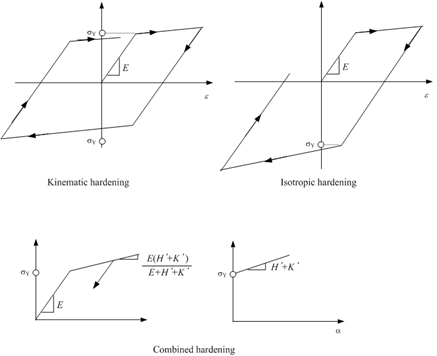
Fig. 7.2-1. Linear hardening
Function으로 지정하는 경우
재료에 대한 1축 인장 실험결과가 있다면, 이를 이용하여 절절히 calibration을 수행할 수 있다. 이 경우 Type=Function을 적절히 이용하면 된다. 주의할 점은 isotropic hardening과 kinematic hardening이 동시에 존재할 때 2차탄성계수 가 그림 7.2-2에 제시된 것과 같은 식을 만족하도록 구성해야 한다는 점이다.
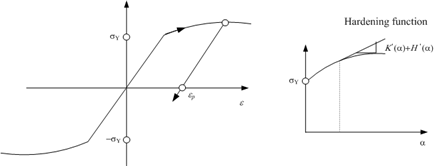
Fig. 7.2-2. Nonlinear hardening
Example
# Linear isotropic hardening case
*Material, Type=vonMises, Name=steel1
2000000. # E, nu, alpha, density
3000., 300.,1. # yield, H, theta, Kinf, K0, delta
# Linear kinematic hardening case
*Material, Type=vonMises, Name=steel2
2000000. # E, nu, alpha, density
3000., 300., # yield, H, theta, Kinf, K0, delta
# Nonlinear isotropic hardening case
*Function, Type=MultiLinear, Name=isoFunc
0. 200.
0.01 210.
*Material, Type=vonMises, Name=steel3
200000. # E, nu, alpha, density
isoFunc # isoHardFunc, kinHardFunc|H
# Nonlinear isotropic hardening, linear kinematic hardneing case
*Material, Type=vonMises, Name=steel4
200000. # E, nu, alpha, density
isoFunc, 20. # isoHardFunc, kinHardFunc|H
# Nonlinear isotropic/kinematic hardneing case
*Material, Type=vonMises, Name=steel5
200000. # E, nu, alpha, density
isoFunc, kinFunc # isoHardFunc, kinHardFunc|H
*Material Type=Tresca
Define Tresca plasticity material model
*Material, Type=Tresca, Name=name
E, nu, alpha, density, StrainHardening|IsotropicHardening
{yield,dyield}|yieldFunc
First dataline
- E: elastic modulus (required)
- nu: Poisson’s ratio (optional, default 0.)
- alpha: themal expansion coefficient (optional, default 0.)
- density: density (optional, default 0.)
- StrainHardening|IsotropicHardening: hardening type(optional, default “StrainHardening”)
Second dataline
- yield,dyield: initial yield value(required), and the derivative after initial yielding(optional, default 0.)
- yieldFunc: yield function(required)
Tresca 재료모델은 항복함수와 소성퍼텐션(flow potential)이 다음과 같다.
경화법칙(hardening rule)은 strain hardening, work harding, isotropic associative hardening rule이 적용가능한데, Tesca 모델에서는 work hardening과 associative isotropic hardening이 동일하다.
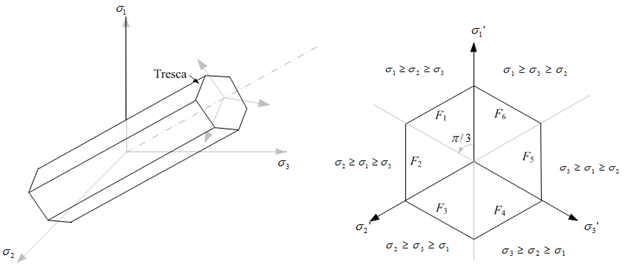
Fig. 7.2-3. Tresca yield criteria
Example
*Function, Type=MultiLinear, Name=trYield
0. 0.
0.01 10.
0.02 15
# no hardening case with sy = 20.
*Material, Type=Tresca, Name=steelT1
2E6, 0.18, 1E-5, 7850 # E, nu, alpha, density
20 # yield, dyield
# linear hardening case with strain hardening
*Material, Type=Tresca, Name=steelT2
2E6, 0.18, 1E-5, 7850 # E, nu, alpha, density
20, 0.1 # yield, dyield
# linear hardening case with work hardening
*Material, Type=Tresca, Name=steelT3
2E6, 0.18, 1E-5, 7850 # E, nu, alpha, density
20, 0.1, StrainHardening|WorkHardening # yield, dyield, StrainHardening|WorkHardening
# nonlinear hardening case with work hardening
*Material, Type=Tresca, Name=steelT4
2E6, 0.18, 1E-5, 7850 # E, nu, alpha, density
trYield # yieldFunc
*Material Type=MohrCoulomb
Define Mohr-Coulomb material
*Material, Type=MohrCoulomb, Name=name
E, nu, alpha, density, StrainHardening|IsotropicHardening
{coh,dcoh}|cohFunc
{fric,dfric}|fricFunc
{dila,ddila}|dilaFunc
First dataline
- E: elastic modulus (required)
- nu: Poisson’s ratio (optional, default 0.)
- alpha: themal expansion coefficient (optional, default 0.)
- density: density (optional, default 0.)
- StrainHardening|IsotropicHardening: hardening type(optional, default “StrainHardening”)
Second dataline
- coh,dcoh: initial value (required) and derivative of cohesion (optional, default 0.)
- cohFunc: function name of cohesion function (required)
Third dataline (frictional quatities)
- fric,dfric: initial value(required) and derivative of friction angle. (optional, default 0.)
- fricFunc: function name of friction angle function (required)
Forth dataline (dilatent quanties)
- dila,ddila: initial value and derivative of dilatent angle (default 0., 0.)
- dilaFunc: function name of dilatent function (optional)
마찰각(frictional angle) 및 팽창각(dialtent angle)의 단위는 라디안이 아닌 degree가 사용된다. 팽창각 관련 값이 마찰각과 같다면, 연관소성흐름 법칙(associative flow rule)이 적용된다. 그렇지 않으면 비연관소성흐름법칙(non-associative flow rule)이 적용된다. 초기 점착력(cohesion0은 반드시 0이 아닌 값을 지정해야 한다. 경화법칙으로 associative isotropic hardening(즉, IsotropicHardening)을 적용할 때는 일정한 마찰각과 팽창각(constant frictional and dilatent angle)이 사용되어야 한다.
Mohr-Coulomb 재료모델은 다음과 같은 항복함수와 소성퍼텐셜을 사용한다.

Fig. 7.2-4. Mohr-Coulomb yield criteria
The hardening rule includes strain hardening and isotropic hardening. In the Mohr-Coulomb model, work hardening does not exist.
Example
# associative flow rule, no hardening
*Material, TYPE=MohrCoulomb, Name=soil1
2E6, 0.18, 1E-5, 7850
20 # coh, dcoh
35 # fric, dfric
35 # dila, ddila
# associative flow rule, strain hardening
# linear hardening of cohesion, constant friction and dilatency
*Material, TYPE=MohrCoulomb, Name=soil2
2E6, 0.18, 1E-5, 7850
20,3.
35,
30.
# associative flow rule, associative isotropic hardening
# linear hardening of cohesion, constant friction and dilatency
*Material, TYPE=MohrCoulomb, Name=soil3
2E6, 0.18, 1E-5, 7850, IsotropicHardening
20,3.
35,
30.
# associative flow rule, associative isotropic hardening,
# linear hardening of cohesion, friction
*Material, TYPE=MohrCoulomb, Name=soil4
2E6, 0.18, 1E-5, 7850
20,3.
35, 0.2
35, 0.2
# non-associative flow rule, strain hardening,
# nonlinear hardening of cohesion, friction, dilatency
*Function, Name=cohFunc
0., 20.
0.001, 25.
0.002, 25.
*Function, Name=fricFunc
0. 35.
0.001, 40.
0.002, 45.
*Function, Name=dilaFunc
0. 30.
0.001 35.
0.002 40.
*Material, TYPE=MohrCoulomb, Name=soil5
2E6, 0.18, 1E-5, 7850
cohFunc
fricFunc
dilaFunc
*Material Type=DruckerPrager
Define Isotropic elasticity material
*Material, Type=DruckerPrager, Name=name
E, nu, alpha, density, StrainHardening|IsotropicHardening
beta
coh,dcoh|cohFunc,
af,daf|afFunc
ap,dap|apFunc
First dataline
- E: elastic modulus (required)
- nu: Poisson’s ratio (optional, default 0.)
- alpha: themal expansion coefficient (optional, default 0.)
- density: density (optional, default 0.)
- StrainHardening|IsotropicHardening: hardening type(optional, default “StrainHardening”)
Second dataline
- beta: beta (required)
3rd dataline
- coh, dcoh: initial value(required) and derivative of cohesion (optional, default 0.,0.)
- cohFunc: function name of cohesion(required)
4th dataline (frictional quantity)
- af, daf: initial value and derivative of alpha. ( default 0., 0.)
- afFunc: function name of alpha (required)
5th dataline (dilatent quantity)
- ap, dap: initial value(required) and derivative of alphaP (dilatency) (optional, default 0.)
- apFunc: function name of alphaP (required)
마찰각(frictional angle) 및 팽창각(dialtent angle)의 단위는 라디안이 아닌 degree가 사용된다. 팽창각 관련 값이 마찰각과 같다면, 연관소성흐름 법칙(associative flow rule)이 적용된다. 그렇지 않으면 비연관소성흐름법칙(non-associative flow rule)이 적용된다. 초기 점착력(cohesion0은 반드시 0이 아닌 값을 지정해야 한다. 경화법칙으로 associative isotropic hardening(즉, IsotropicHardening)을 적용할 때는 일정한 마찰각과 팽창각(constant frictional and dilatent angle)이 사용되어야 한다.
Drucker-Prager 재료모델에서 항복함수와 소성포턴셀은 다음과 같다.
▪ Flow potential : same to yield function
경화법칙은 strain hardening과 isotropic hardening이 존재한다. Drucker-Prager 모델에서는 work hardening이 존재하지 않는다.
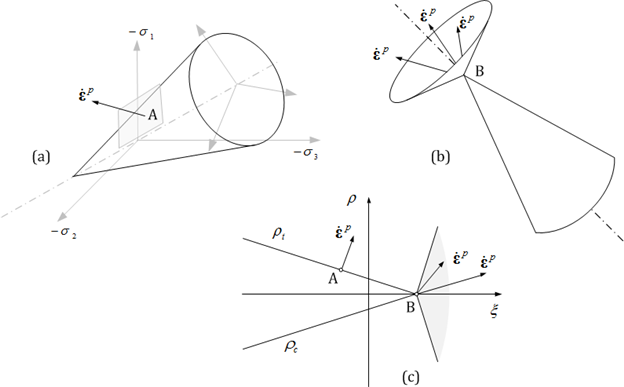
Fig. 7.2-5. Flow rule of Drucker-Prager model
Example
*Material, TYPE=DruckerPrager, Name=concreteDP
2E6, 0.18, 1E-5, 7850, StrainHardening # E, nu, alpha, density, StrainHardening|IsotropicHardening
4 # beta
12.3 # coh,dcoh|cohFunc,
20 # af,daf|afFunc
20 # ap,dap|apFunc
*Material Type=ConcreteDamage
Define concrete damage plasticity
*Material, Type=ConcreteDamage, Name=name
E, nu, alpha, density
fc, Dc, wc,
ft, Dt, wt,
a, Kc, ap,ecc
First dataline
- E: elastic modulus (required)
- nu: Poisson’s ratio (optional, default 0.)
- alpha: themal expansion coefficient (optional, default 0.)
- density: density (optional, default 0.)
Second dataline
- fc,Dc,wc: compressive uniaxial yield function(required), damage function(option, default none), and recovery(optional, default 0.)
3rd dataline
- ft,Dt,wt: tensile uniaxial yield function(required), damage function(option, default none), and recovery(optional, default 0.)
4th dataline if necessary (parameters for yield surface and flow potential)
- a: parameter for yield surface related to biaxial stress condition (optional, default 0.14),
- Kc: parameter for yield surface related to triaxial stress condition (optional, default 2/3),
- ap: parameter for flow potential related to dilatency(optional, default 0.2)
- ecc: parameter for flow potential, the eccentricity(optional, default 0.1)
Example
*Function, Name=chard
0., 20.
0.001, 25.
0.002, 25.
*Function, Name=thard
0., 2.
0.001, 1.
0.002, 0.2.
*Material, TYPE=ConcreteDamage, Name=concreteCD
29188.6, 0.18, 2300, 1e-05 # E, nu, alpha, density
chard, , 1 # fc, Dc, wc n thard, , 1 # ft, Dt, wt
0.12 , 0.666667, 0.2, 0.1 # a, Kc, ap, ecc
*Material Type=UConcrete
Define uniaxial concrete
*Material, Type=UConrete, Name=name
CEnvFunc, Plastic|Secant|CIEFunc, alpha, density, timeProp
TEnvFunc, Plastic|Secant|TIEFunc
First dataline
- CEnvFunc: Compressive envelope function (required)
- Plastic|Secant|CIEFunc: - Plastic unloading, Secant unloading, 또는 damage plastic unloading 시의 함수를 지정 (optional, default Plastic)
- alpha: themal expansion coefficient (optional, default 0.)
- density: density (optional, default 0.)
- timeProp: Combined viscosity material given by *Material, Type=UConcreteTime. (optional)
2rd dataline if necessary
- TEnvFunc: Tensile envelope function (optional)
- Plastic|Secant|TIEFunc: - Plastic unloading, Secant unloading, 또는 damage plastic unloading 시의 함수를 지정 (optional, default Secant)
- TIEFunc: Tensile unloading function iff Plasticity (optional)
UConctete 모델은 콘크리트의 압축측 제하와 재재하에서 발생하는 에너지 소산을 무시하여 간략화한 소성손상모델이다. 압축 및 인장측에 대해 독립적으로 파괴포락선이 정의되어야 하며, 제하/재제하(unloading/reloading)시 손상이 없는 소성모델(이하 plastic), 소성손상모델(이하 damage plastic), 소성탄성모델(이하 damage elastic)을 선택할 수 있다. 만약 소성손상모델을 적용하는 경우 마지막으로 경험한 변형률(\(\small\epsilon_{cun}\) 또는 \(\epsilon_{tun}\)에 대응하는 점 \(\small(\epsilon_{cun},\sigma_{cun})\) 또는 \(\small(\epsilon_{tun},\sigma_{tun})\)과 소성변형률함수에서 지정된 소성변형률( \(\small\epsilon_{cpl}\) 또는 \(\epsilon_{tpl}\)에 대응하는 점을 잇는 선분을 따라 제하 및 재재하가 이루어지므로 \(\small(\epsilon_{cpl},\sigma_{cun})\), \(\small(\epsilon_{tpl},\sigma_{tun})\)형태의 함수 지정이 필요하다.

Fig. 7.2-6. Failure envelope, unloading/reloading of UConcrete
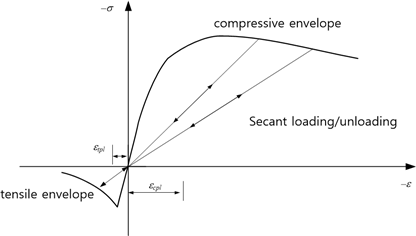
Fig. 7.2-7. Secant unloading/unloading of UConcrete
반복하중(cyclic loading) 조건에서는 소성변형률에 대응하는 항복값까지 탄성거동을 이후 파괴포락선을 따라 항복한다. Secant loading/unloading을 지정한 경우는 해당하는 비탄성변형률이 없다.
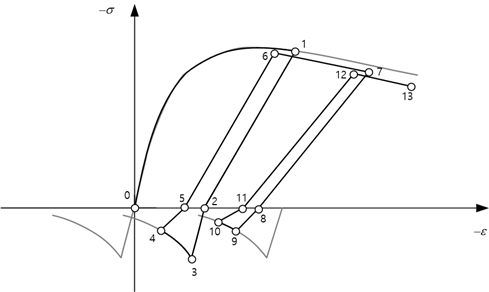
Fig. 7.2-8. Cyclic loading of UConcrete
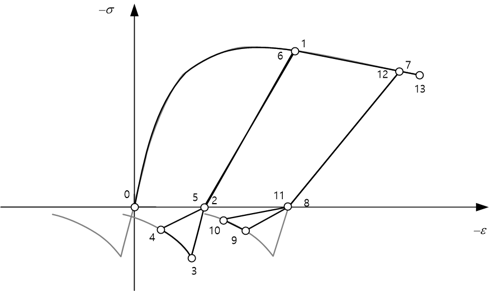
Fig. 7.2-9. Cyclic loading of Unconcret for tensile secant unloading
Example
*Function, Type=MPPCEnv, Name=MPP
27, 25000, 0.002 # fco, Ec, eco, ecu, fcc, esp
*Function, Type=MPPCIE, Name=MPPIE
MPP # compressiveEnv, epeak
*Function, Type=MaekawaTEnv, Name=Maekawa
MPP, 3, 0.4 # compressiveEnv,ft, c
*Material, Type=UConcrete, Name=Mander
MPP, MPPIE
Maekawa,Secant
*Material, Type=UConcrete, Name=Mander
MPP
Maekawa, Secant
*Material Type=USteel
Define uniaxial steel model based on Menegotto-Pinto model
*Material, Type=USteel, Name=name
E0, yield, E1, R0,a1,a2, a3,a4, eu, alpha, density
First dataline
- E0: Initial tangent modulus (required)
- yield: yield stress ( required )
- E1: Second tangent modulus (optional, default 0.)
- __R0,a1,a2:__curvature parameters (optional, default 20, 0, 0)
- a3,a3: isotropic hardening parameters (optional, default 0, 1.)
- eu: ultimate strain (optional, default 0). If eu = 0., then ultimate strain is not checked.
- alpha: themal expansion coefficient (optional, default 0.)
- density: density (optional, default 0.)
USteel uses Menegotto-Pinto model with some modifications of partial reloading problem. It can be used for modeling rebar or prestressing steel.
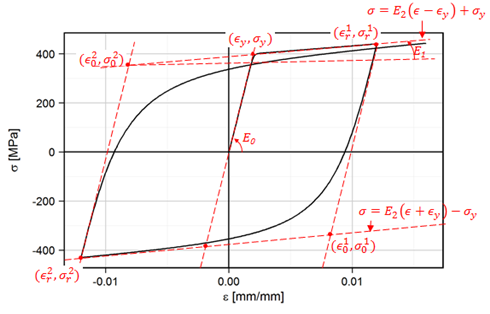
Fig. 7.2-10. Menegotto-Pinto Model
The recommended values of modeling rebar and 7-wire strand is given in the example.
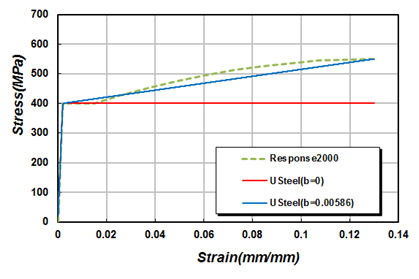
Fig. 7.2-11. Stress-strain curve of a weldable rebar with 400 MPa yield strength
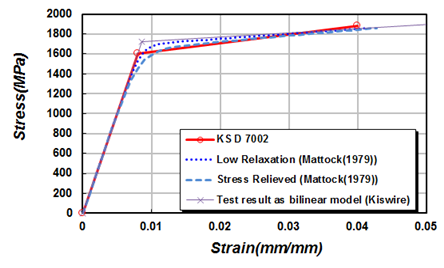
Fig. 7.2-12. Stress-strain curve of 7-wire strand with ultimate strength 1860 MPa
Example
# 400 MPa rebar without hardening
*Material, Type=USteel, Name=SD40
200000,400, 0, 20,18.5,0.15, 0.01, 7, 0.08
# E0, yield, E1, R0,a1,a2, a3,a4, eu, alpha, density
# 400 MPa weldable rebar without hardening
*Material, Type=USteel, Name=SD40W
200000, 400, 0, 20,18.5,0.15, 0.01, 7, 0.13
# E0, yield, E1, R0,a1,a2, a3,a4, eu, alpha, density
# 400 MPa rebar with hardening
*Material, Type=USteel, Name=SD40-U
200000, 400, 0.01282*200000, 20,18.5,0.15, 0.01, 7, 0.08
# 400 MPa weldable rebar with hardening
*Material, Type=USteel, Name=SD40W-U
200000, 400, 0.0586*200000, 20,18.5,0.15, 0.01, 7, 0.13
# Stress-relieved 7-wire strand with ultimate strength 1860 MPa
*Material, Type=USteel, Name=STendon
200000, 1652.891, 200000*0.03, 6, 0., 0., 0, 1, 0.0428
# Low relaxation 7-wire strand with ultimate strength 1860 MPa
*Material, Type=USteel, Name=RTendon
200000, 1694.915, 200000*0.025, 10,0.,0., 0, 1, 0.0415
*Material Type=GapHook
1축 gap-hook 재료를 지정
*Material, Type=GapHook, Name=name
kg,g, kh,h
First dataline
- kg,g: tangent and gap in compression part (optional, default 0.,0.)
- __kh,h:__tangent and hook tension part (optional,default 0.,0.)
GapHook 명령으로 tension only나 compression only 등으로 모델링할 수 있다. kg와 kh가 동시에 0이 될수 없다.
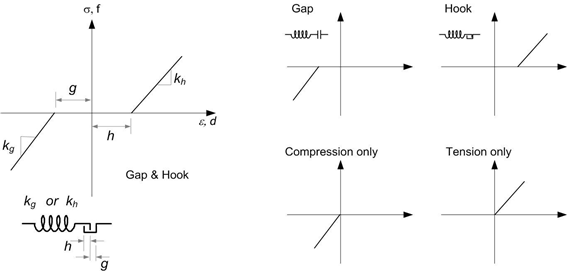
Fig. 7.2-135.GapHook Model
Example
*Material, Type=GapHook, Name=gaphook
5E5, 0.1, 4E5, 0.2 # kg, g, kh, h
# tension only
*Material, Type=GapHook, Name=cable
0, 0, 5E5 # kg, g, kh, h
# compression only
*Material, Type=GapHook, Name=contactSpring
5E5 # kg, g, kh, h
*Material Type=Acoustic
Acoustic solid 요소용 acoustic material을 지정
*Material, Type=Acoustic, Name=name
bulk, density
First dataline
- bulk: Bulk modulus (required). If zero bulk moduls is given, the acoustic medium is assumed to be incompressible (Laplace equation is used)
- __density:__density (required)
Example
*Material, Type=Acoustic, Name=water
2190E6, 1000
*Material Type=Porous
Porous solid 요소용 porous material을 지정
*Material, Type=Acoustic, Name=name
solidMat, wBulk, wDen, porosity, perm
First dataline
- solidMat: normal material for solid
- wBulk: bulk modulus of water (required)
- wDensity: water density(required)
- porosity: porosity (required)
- perm: permeability (required)
Example
*Material, Type=Porous, Name=water
mat, 1000, 100, 0.1, 1000